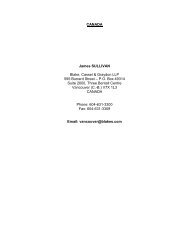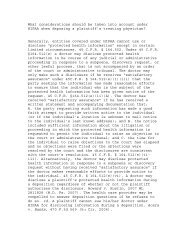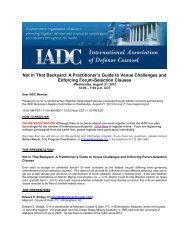Defense Counsel Journal - International Association of Defense ...
Defense Counsel Journal - International Association of Defense ...
Defense Counsel Journal - International Association of Defense ...
Create successful ePaper yourself
Turn your PDF publications into a flip-book with our unique Google optimized e-Paper software.
The Global Supply Chain Page 417with dire impacts to companies. Externalrisks are categorized as: Demand Risk: Potential oractual disturbances to the flow <strong>of</strong>product, information, and cashemanating from within thenetwork between the focal firmand the market. 17Supply Risk: Actual or potentialdisturbance <strong>of</strong> the flow <strong>of</strong>product or informationemanating within the network,upstream to the focal firm. 18 Geo-political Risk: Naturaland/or political risks that canoccur. This category includesevents such as natural disastersand political upheaval. This riskcan impact the firm directly orthrough suppliers and customers.The final category is the most unnerving.While all external risks are, by definition,outside the control <strong>of</strong> the company, geopoliticalrisks pose the greatest threat <strong>of</strong>significant disruption or cessation <strong>of</strong> thesupply chain. A geo-political event couldhave devastating effects on the supplychain system <strong>of</strong> an unprepared company.Raw materials, supply routes,manufacturing and the end marketplacemay be eliminated for an extended period.II. He Who Fails to Plan, Plans to FailTo minimize its risks, a companymust fully understand the entirety <strong>of</strong> its17 See Braithwaite, supra note 11.18 Id.supply chain and, more importantly, itspoints <strong>of</strong> vulnerability. Conducting anobjective assessment allows a company toprepare for interruptions, create flexibilityin its supply chain and be able to respondin kind to potential disruptions.Mapping. First, a company should drawa map <strong>of</strong> its supply chain and considerwhat perils may arise that would interruptits supply chain. This may appear simpleand obvious but it is easy to overlook andeasy to make certain assumptions about asupply chain absent a clear and objectiveview <strong>of</strong> the chain as a whole.Consider a company that minescopper in Russia, refines the copper intotubing in the Middle East and distributesthe finished product throughout theUnited States. By mapping the supplychain and considering the potential perilsthat may occur, the company can choosewhat risks it will transfer and what risks itwill bear. Because mining and fabricatingare inland, they are unlikely to be affectedby coastal flooding or wind damage. Thelocation <strong>of</strong> these activities may beaffected by an earthquake, industrialaccident (Russia) or political unrest(Middle East).In the scenario described above, thecompany could take additional steps tomitigate potential disruptions. Thecompany could position inventory tobuffer against uncertainties <strong>of</strong> demand oruncontrollable environmental risks. Bylimiting shipment to the refining areaaccording to demand, the company couldlimit the risk <strong>of</strong> lost materials due topolitical unrest. The company could alsoshift refining elsewhere without having tore-direct significant amounts <strong>of</strong> materialsalready in transit.












